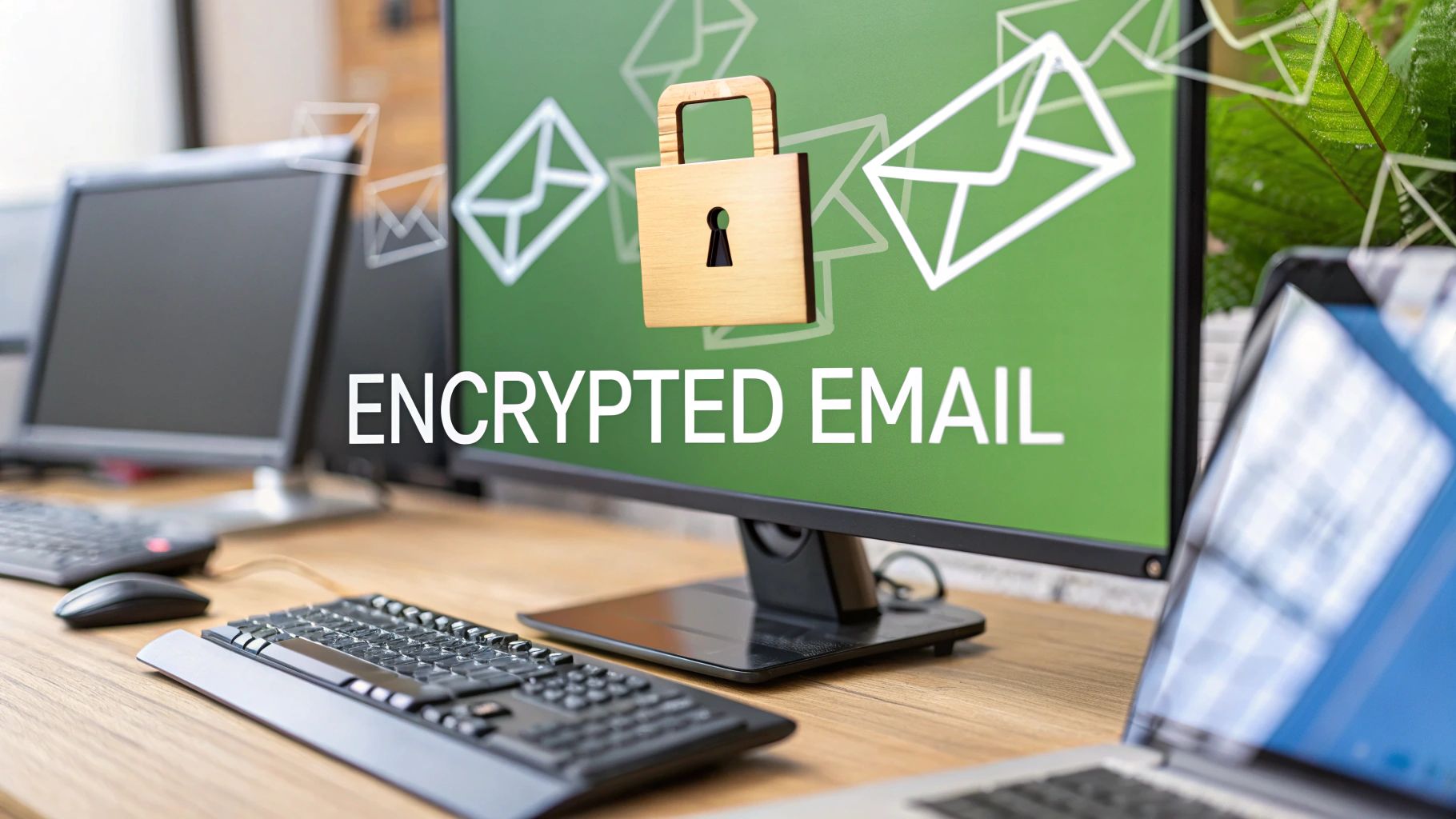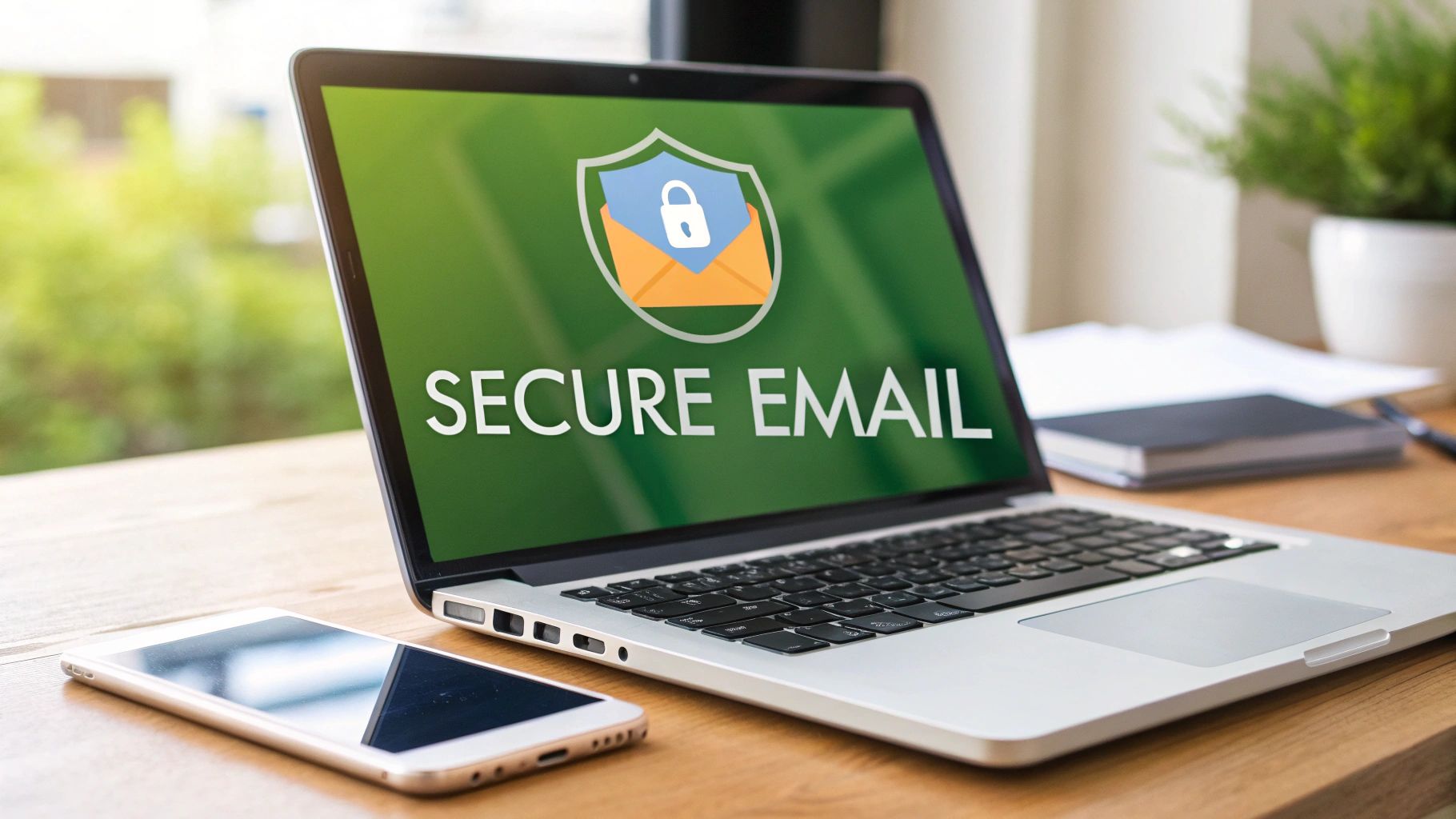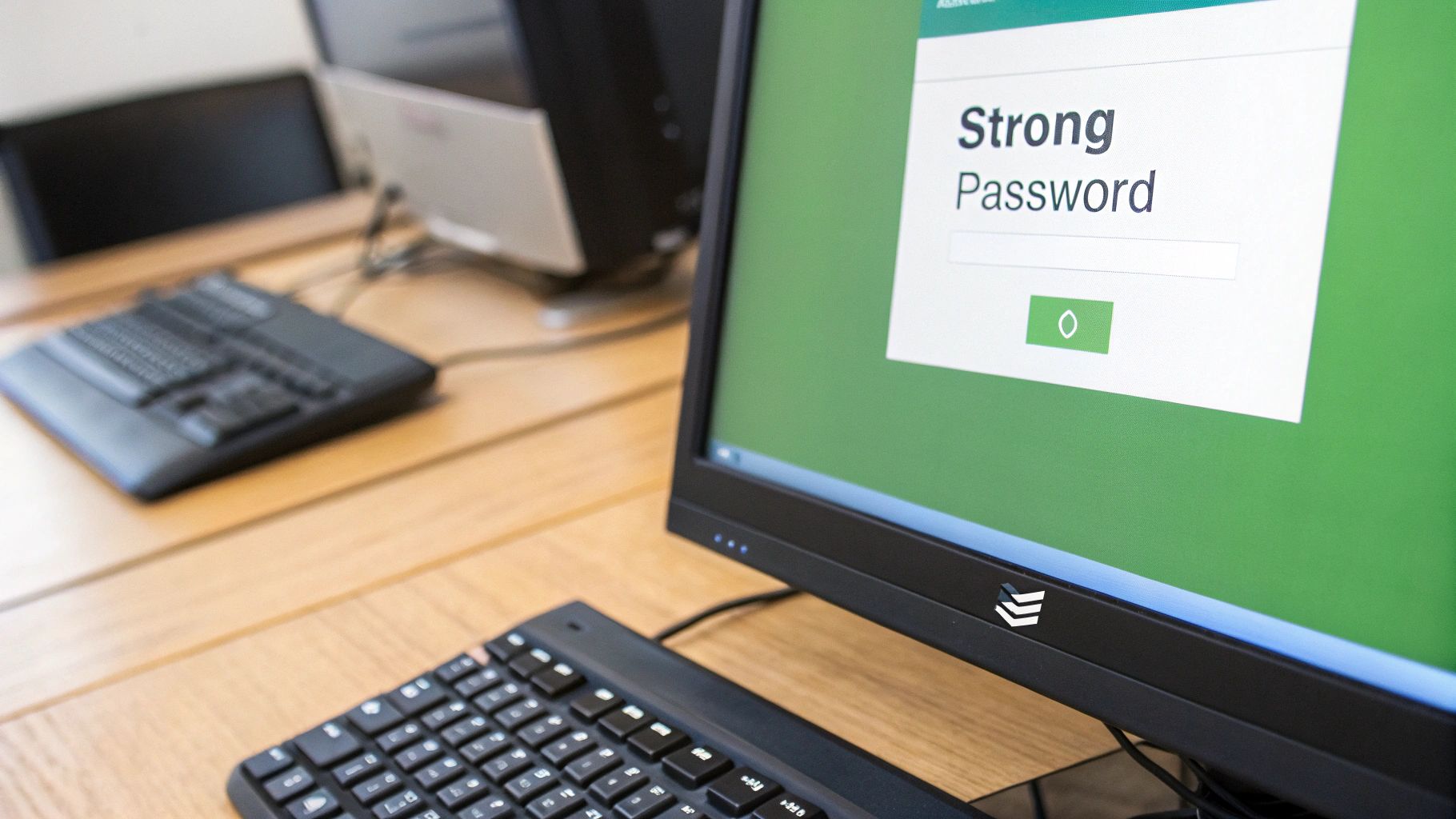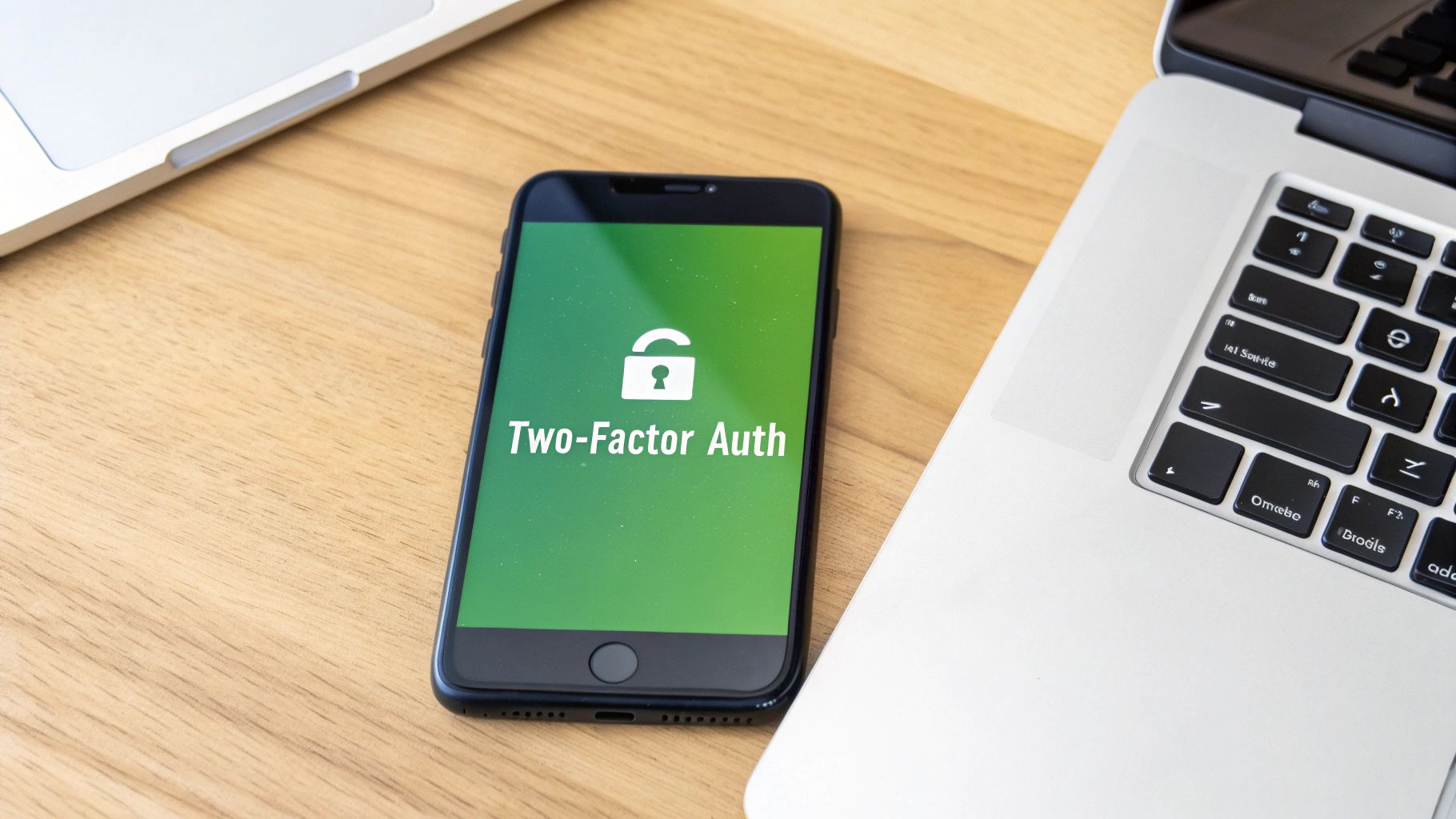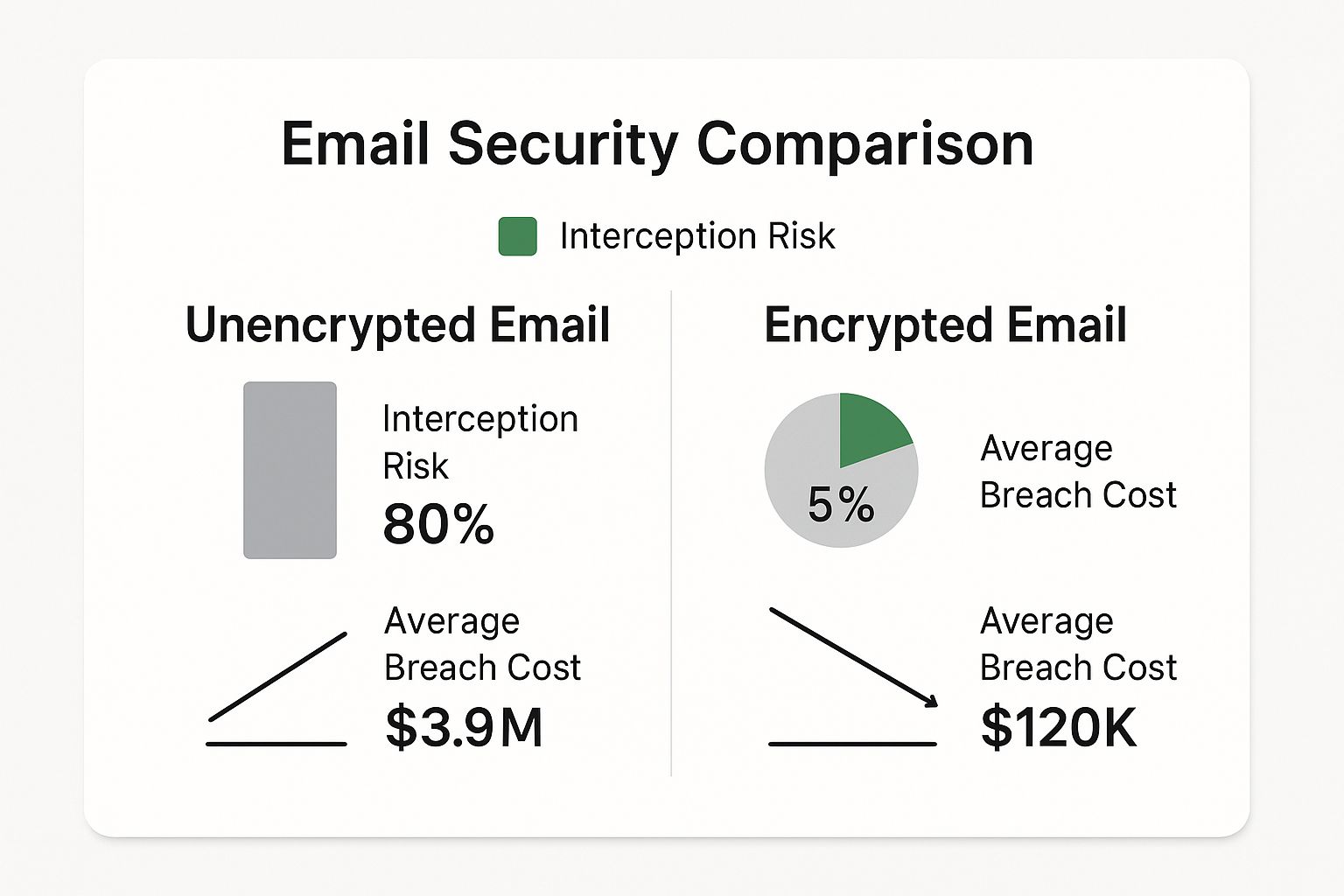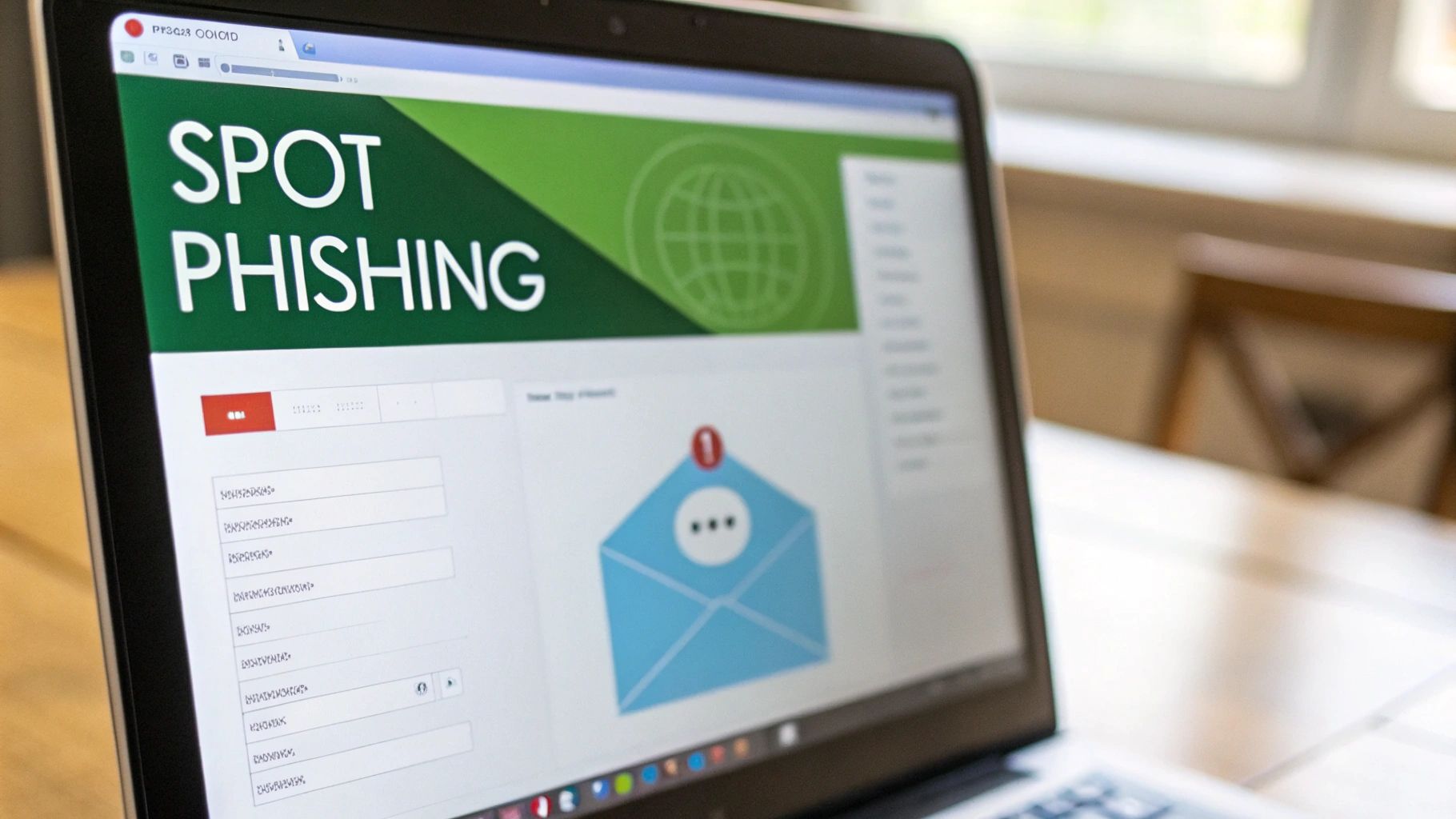Your standard email inbox is a digital liability. Services like Gmail and Outlook, while convenient, often treat your personal and business communications as a product, scanning them for advertising data and leaving them vulnerable to surveillance and data breaches. For anyone handling sensitive information – from client contracts and financial records to personal health details – relying on these free services is a significant risk. Encrypted email isn't just a niche tool for activists or security experts anymore; it's a fundamental necessity for maintaining digital privacy and control.
This comprehensive guide is designed to cut through the noise and technical jargon, helping you find the best encrypted email services for your specific needs. We’ve done the heavy lifting, rigorously testing and analyzing the leading platforms on the market. Whether you're a privacy-focused individual tired of invasive ads, a small business owner needing secure client communication with a custom domain, or an IT professional sourcing a solution for your team, this resource provides the clarity you need to make an informed decision.
Inside, you'll find detailed, hands-on reviews of services like ProtonMail, Tuta, Typewire, and more. Each breakdown covers critical factors:
- Security Architecture: A straightforward look at their encryption protocols (like PGP and end-to-end encryption) and what they actually protect.
- Practical Use Cases: Honest assessments of who each service is truly for, from individual users to enterprise teams.
- Key Features & Limitations: An analysis of standout features and potential drawbacks, so you know exactly what you’re getting.
- Pricing and Tiers: Clear comparisons of free and paid plans to match your budget and requirements.
We provide screenshots for a real-world feel and direct links to each platform, making your transition to a secure inbox as seamless as possible. Forget marketing fluff; this is your definitive roadmap to reclaiming your digital privacy.
1. Typewire
Typewire positions itself as a robust, privacy-first email hosting platform, making it a powerful contender for one of the best encrypted email services available. It's engineered from the ground up to provide users with complete control over their digital communications, eliminating ads, tracking, and data mining entirely. This commitment makes it an exceptional choice for privacy-conscious individuals, small businesses, and IT professionals who need to manage secure communications without compromise.
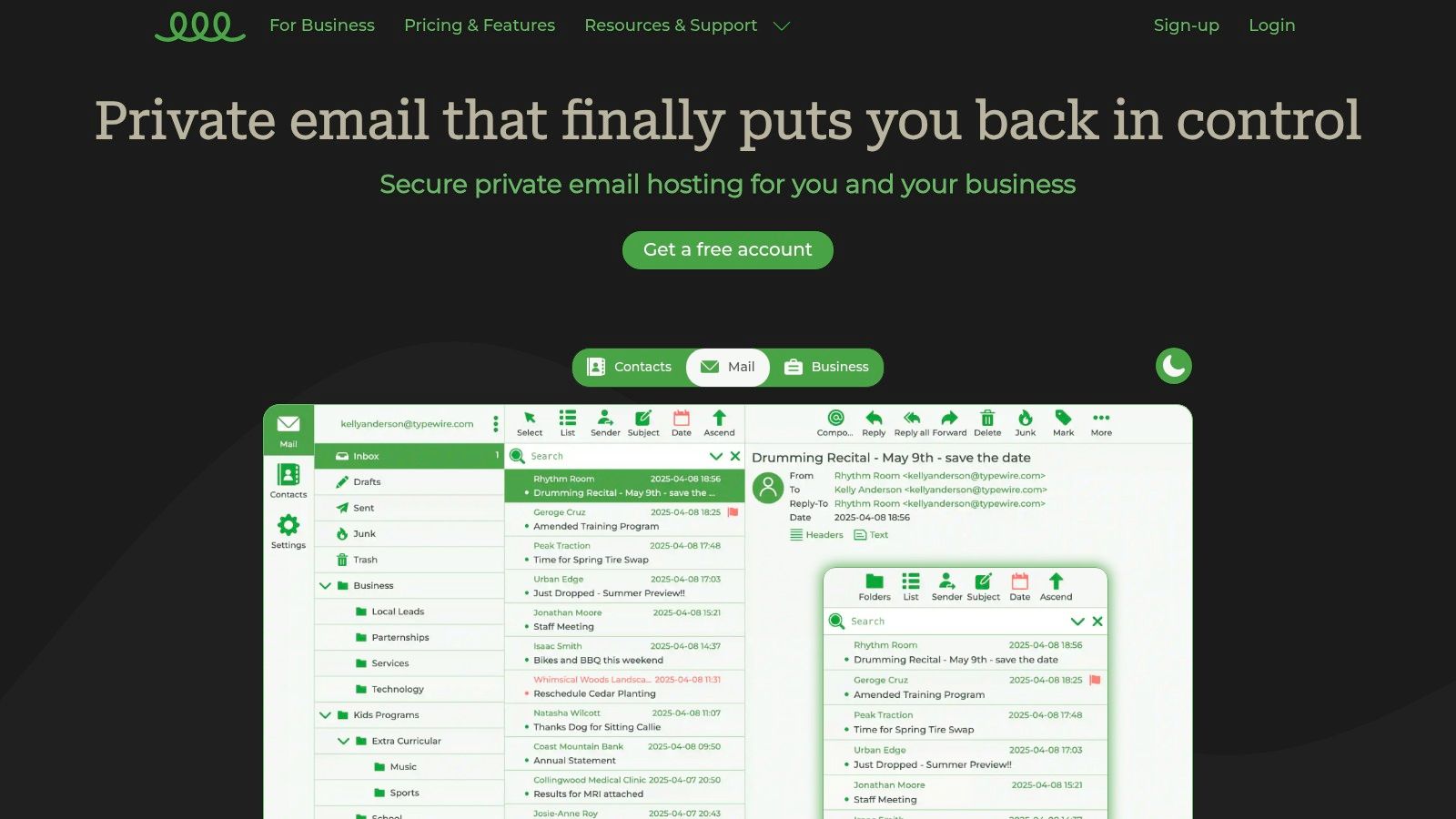
What truly sets Typewire apart is its infrastructure. Unlike many competitors that rely on third-party cloud providers, Typewire operates on its own privately owned and managed data centers in Vancouver, Canada. This provides a significant security advantage by minimizing external data exposure and reinforcing network privacy at a fundamental level.
Key Strengths and User Experience
Typewire’s interface is clean, fast, and highly intuitive, clearly designed by email power users. It includes both light and dark modes and is fully responsive for seamless access across devices. The user experience is streamlined, making tasks like setting up custom domains or managing team accounts straightforward.
Advanced anti-spam and virus filters are another core strength. The system is exceptionally effective at reducing clutter, with algorithms that continuously learn and improve, ensuring your inbox remains clean and secure.
Practical Use Cases
- Small to Medium-Sized Businesses: SMBs can leverage custom domain hosting to establish a professional, branded communication channel. The platform's team management tools simplify adding or removing users, making it scalable as the business grows.
- Privacy-Conscious Individuals: For users transitioning from Gmail or Outlook, Typewire offers a secure haven. Its strict no-tracking policy means personal conversations remain private, free from invasive ad targeting and data profiling.
- IT Administrators: Security professionals will appreciate the control offered by privately owned infrastructure. The platform provides the tools needed to enforce strict communication policies and protect sensitive organizational data effectively.
Pricing and Access
Typewire offers a flexible pricing structure that includes a free tier, making it accessible to everyone. For more advanced features like custom domains and increased storage, users can opt for Basic or Premium plans.
| Plan | Price (Billed Annually) | Key Features |
|---|---|---|
| Free | $0 | 1 GB storage, basic security features |
| Basic | $2.50/month | 10 GB storage, custom domain support, priority support |
| Premium | $5.00/month | 25 GB storage, advanced team management, enhanced security |
A 7-day free trial is available for paid plans, allowing you to test its full capabilities risk-free.
Pros:
- Privacy-First Design: Guarantees zero tracking, no ads, and no data mining.
- Private Infrastructure: Hosts on its own Canadian servers for enhanced security and data sovereignty.
- User-Friendly Interface: Clean, responsive design with light and dark modes.
- Advanced Security: Powerful anti-spam and virus protection.
- Custom Domain Support: Ideal for establishing a professional brand identity.
Cons:
- Fewer Integrations: Lacks the extensive third-party app ecosystem of larger providers like Google Workspace or Microsoft 365.
- Paid Tiers for Full Features: Access to custom domains and advanced tools requires a paid subscription.
Website: https://typewire.com
2. ProtonMail
Based in Switzerland, a country known for its stringent privacy laws, ProtonMail has established itself as a cornerstone in the secure communication space. It stands out by offering robust end-to-end encryption by default, ensuring that no one, not even ProtonMail itself, can access the content of your emails. This makes it an exceptional choice for journalists, activists, and anyone serious about keeping their digital correspondence confidential.
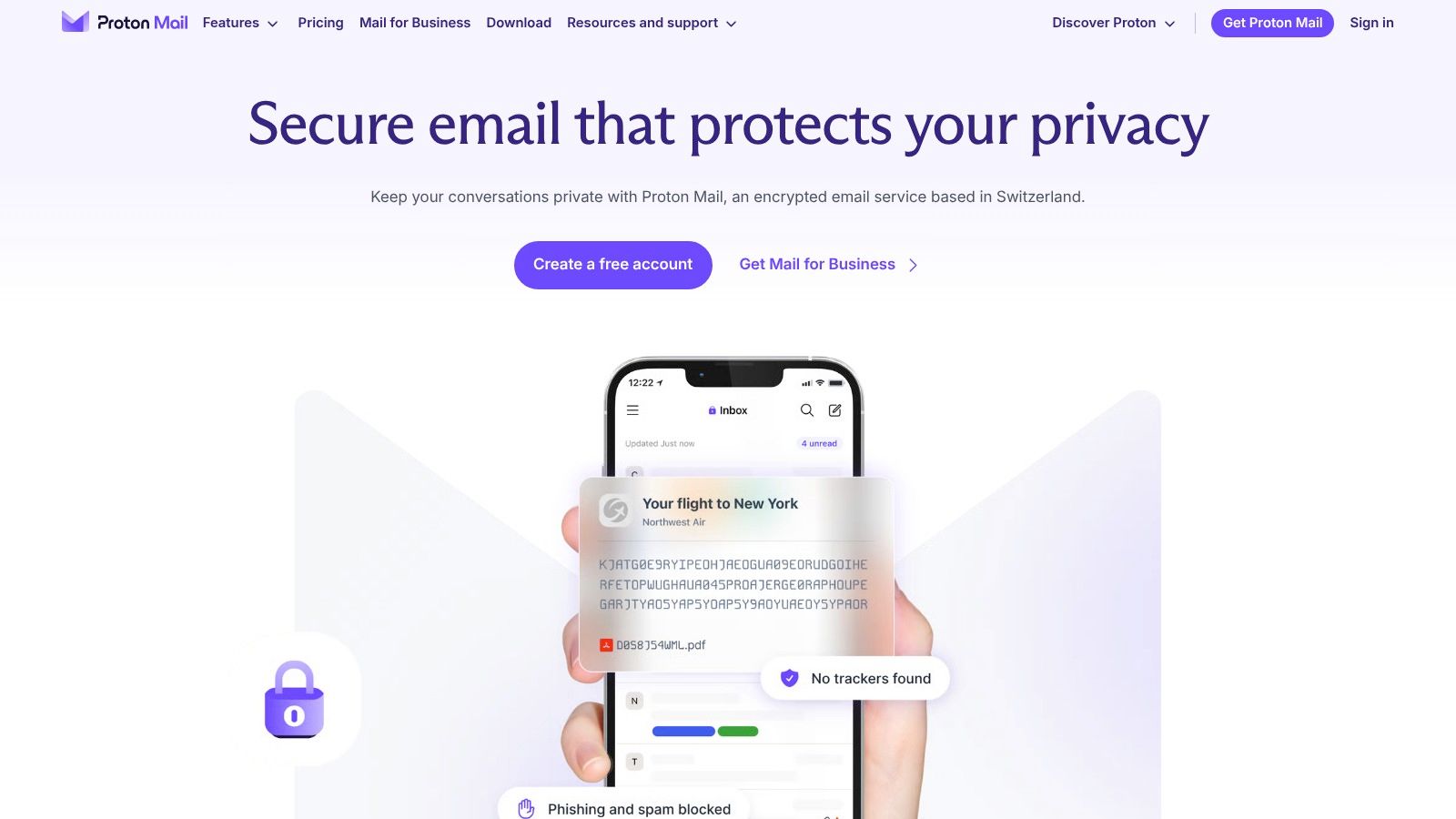
The platform’s user experience is clean and intuitive, closely resembling traditional email clients, which significantly lowers the barrier to entry for users new to encrypted services. One of its most practical features is the ability to send self-destructing emails, even to non-ProtonMail users, by setting an expiration timer.
Key Features and Pricing
ProtonMail operates on a freemium model. The free plan is quite generous for personal use, though it comes with storage limitations (1 GB) and a cap on daily messages. For professionals and businesses, the paid plans unlock crucial features.
- Proton Mail Plus: Starts at €4.99/month, offering 15 GB of storage, one custom email domain, and expanded sending limits.
- Proton Unlimited: At €12.99/month, this bundle includes all Proton services (Mail, Calendar, Drive, VPN) with 500 GB of total storage and support for three custom domains.
The open-source nature of its applications adds a layer of trust and transparency, allowing the security community to vet its code. For those exploring different providers, you can see how ProtonMail stacks up against other top-tier options by reviewing this guide on finding the best encrypted email solutions. Its combination of Swiss legal protection, user-centric design, and a strong feature set makes it one of the best encrypted email services available today.
Website: https://proton.me/mail
3. Tuta (formerly Tutanota)
Operating from Germany, Tuta (formerly Tutanota) has carved out a strong reputation for its unwavering commitment to privacy and open-source principles. It offers end-to-end encryption not just for emails but also for its integrated calendar and contacts, providing a full-suite solution for secure personal information management. Its standout feature is the pioneering implementation of post-quantum cryptography, ensuring that user data remains secure against future threats from quantum computers.
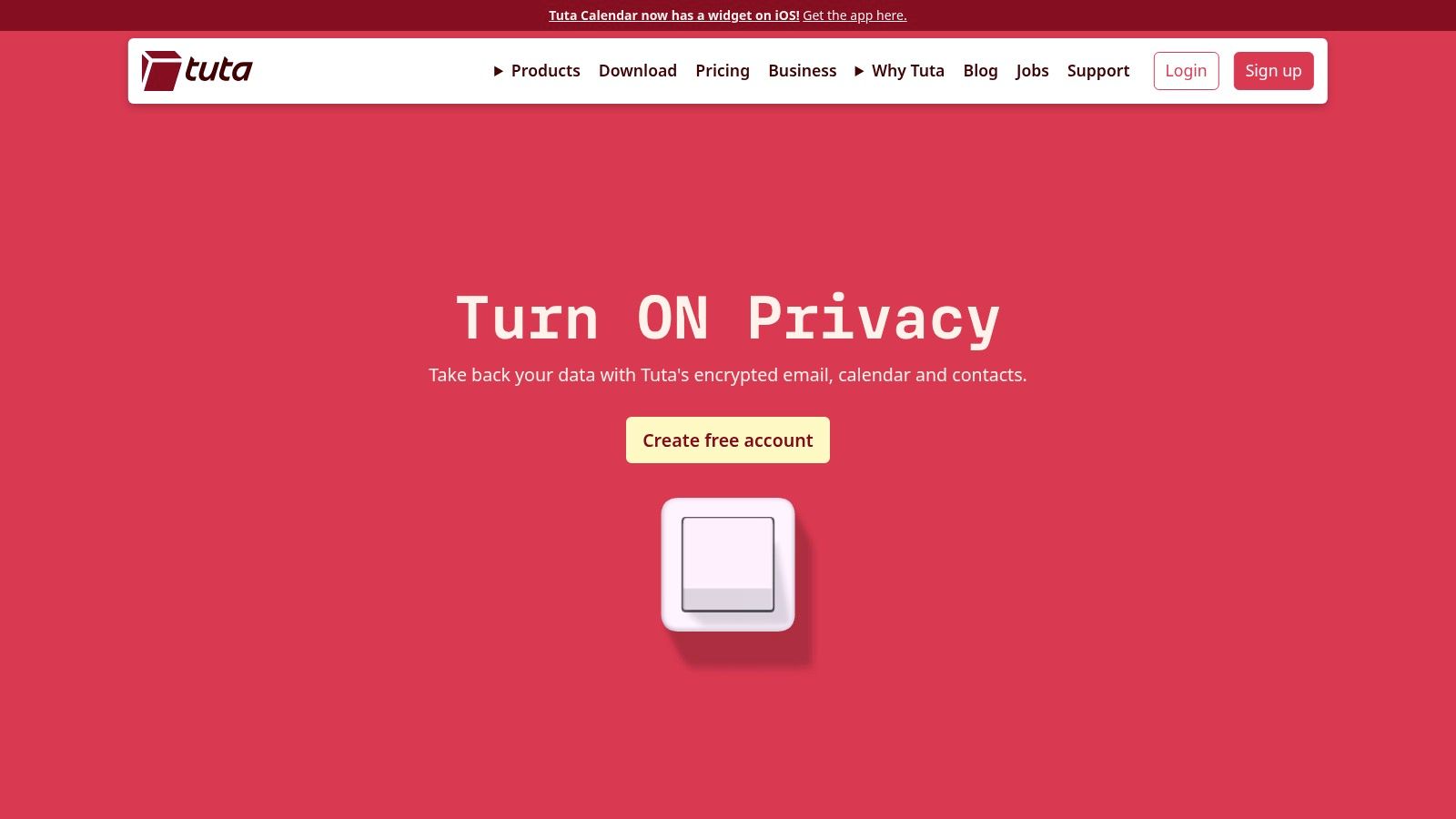
The user interface is clean, fast, and completely free of ads, reflecting Tuta’s core belief in a private, tracking-free experience. This makes it an excellent choice for privacy advocates and anyone looking to de-Google their digital life without sacrificing usability. Its open-source nature allows for complete transparency, as its code is publicly available for security audits.
Key Features and Pricing
Tuta provides a compelling free tier and affordable paid plans, making it accessible for a wide range of users. The free plan is ideal for individual use but comes with a 1 GB storage limit and does not support custom domains.
- Revolutionary Plan: Starts at €3.60/month, providing 20 GB of storage, three custom domains, and 15 alias email addresses.
- Legend Plan: For €9.60/month, users get 500 GB of storage, ten custom domains, and 30 alias addresses, along with premium support.
By encrypting the entire mailbox by default, Tuta ensures that all stored data is inaccessible to anyone but the user. This comprehensive approach underscores the top benefits of using encrypted email for protecting sensitive communications. With its forward-thinking security and user-first philosophy, Tuta rightly earns its spot among the best encrypted email services.
Website: https://tuta.com
4. Hushmail
Based in Canada, Hushmail has carved out a niche by providing secure email solutions specifically tailored for professional sectors, particularly healthcare and law. It leverages OpenPGP standards to deliver end-to-end encryption, ensuring that sensitive client communications remain confidential. Its standout feature is its focus on compliance, offering solutions that meet the stringent requirements of regulations like HIPAA.
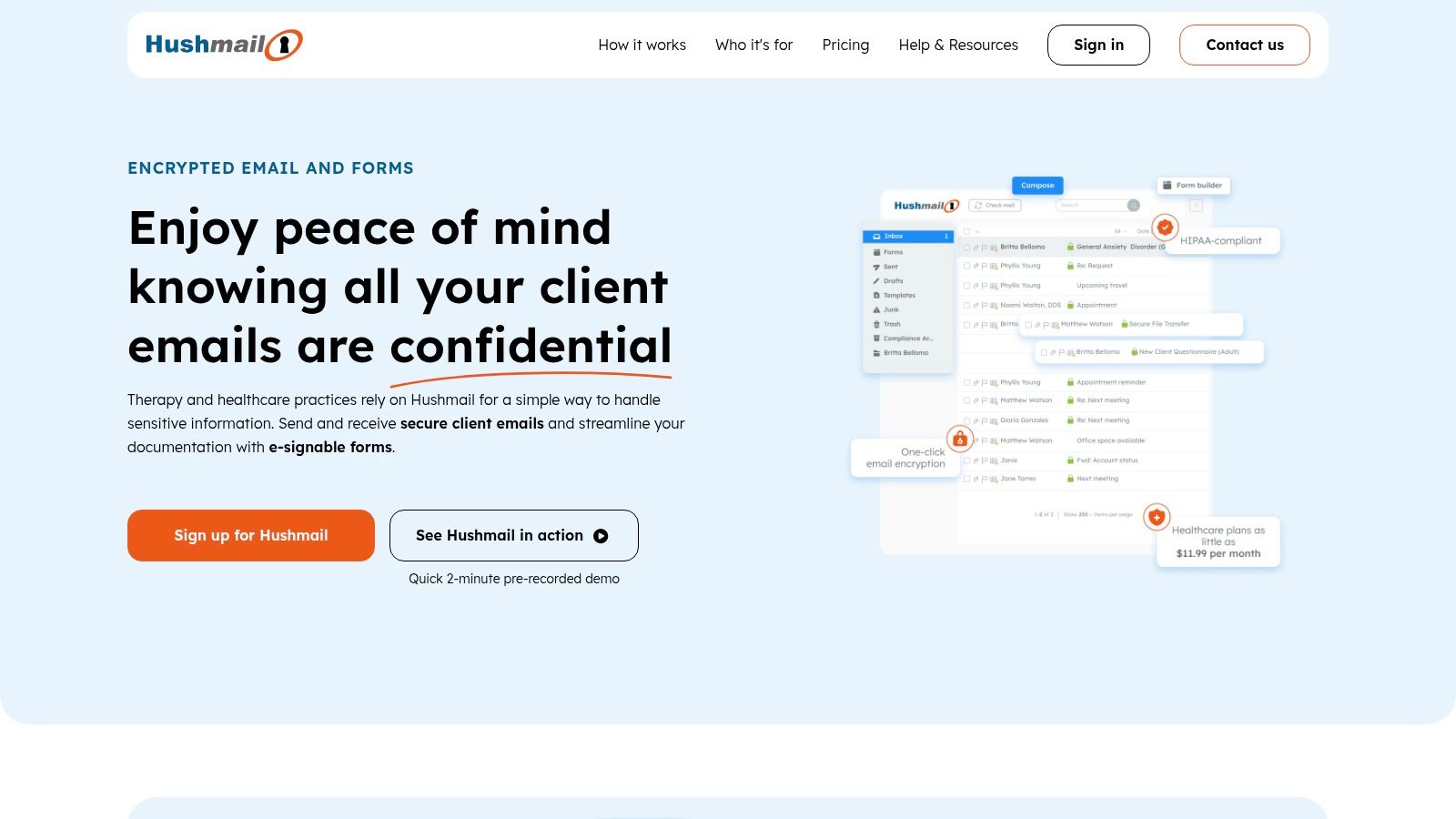
The platform is designed with a user-friendly interface, making it accessible even for those not technically inclined. A key differentiator is the integration of secure web forms and electronic signatures, which streamlines client intake and data collection for businesses. While it offers a robust service, its primary drawback is the absence of a free plan, positioning it as a premium-only option.
Key Features and Pricing
Hushmail's pricing structure reflects its focus on professional and business users, with no freemium tier available. Each plan is designed to meet specific industry needs, from solo practitioners to small businesses.
- Hushmail for Personal Use: Starts at $49.98 per year, providing 10 GB of storage and two-step verification.
- Hushmail for Small Business: Priced at $5.99 per user/month, this plan includes custom domain support, secure web forms, and an email archive.
- Hushmail for Healthcare: Begins at $9.99 per month, offering HIPAA-compliant email and forms, plus a signed Business Associate Agreement (BAA).
Its industry-specific features make Hushmail one of the best encrypted email services for professionals who handle legally protected information. The combination of strong encryption, regulatory compliance, and integrated forms provides a comprehensive solution that goes beyond simple secure messaging, directly addressing the workflow needs of legal and medical practices.
Website: https://www.hushmail.com
5. Mailfence
Operating from Belgium, Mailfence leverages the country's strong privacy legislation to offer a secure and private email suite. It distinguishes itself by integrating end-to-end encryption using the open-standard OpenPGP, not just for email but across its entire suite of tools. This makes it a comprehensive solution for users who want to manage their calendars, contacts, and documents within the same encrypted ecosystem, ensuring holistic data protection.
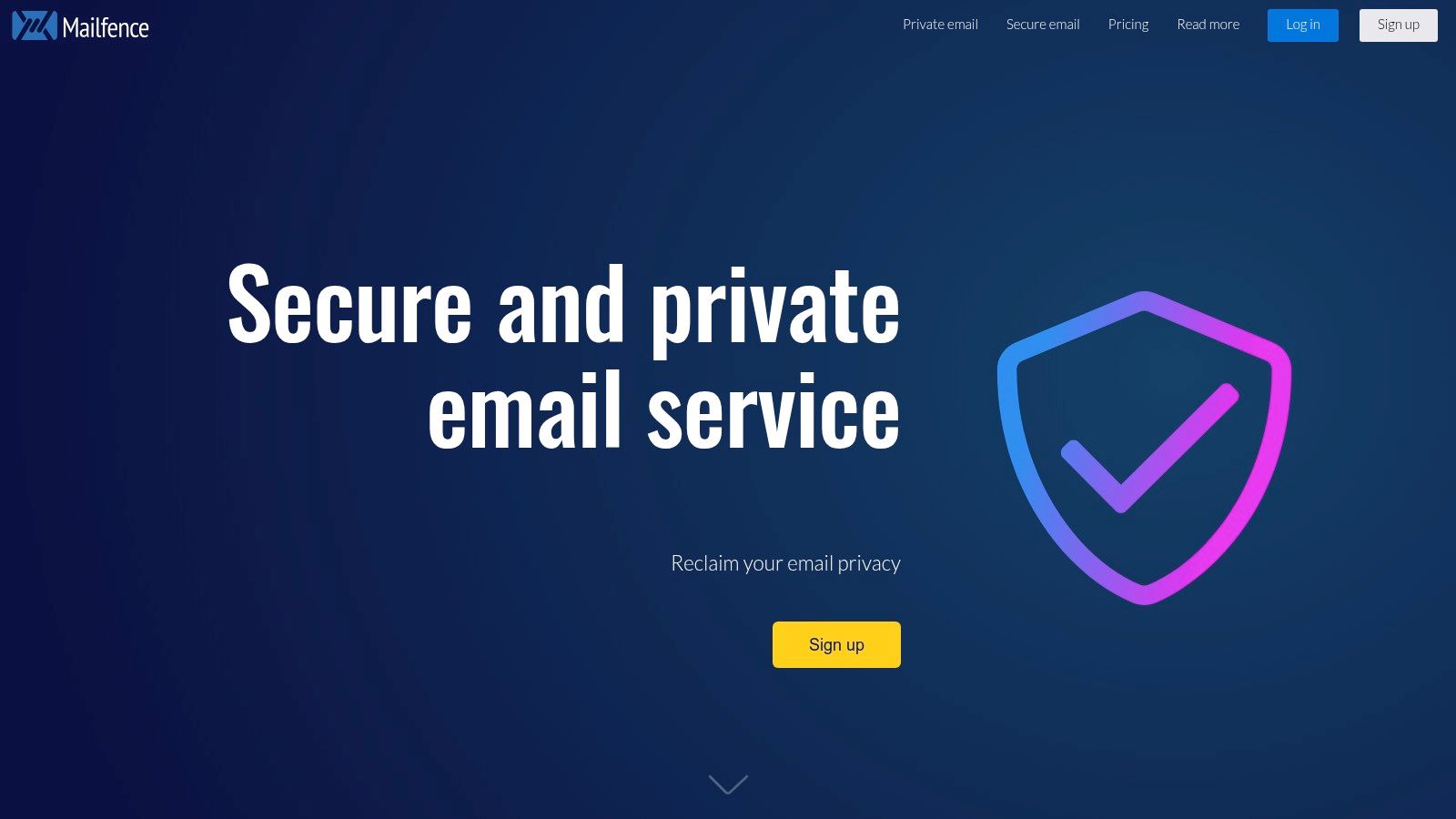
The platform’s strength lies in its full collaboration suite, which includes an encrypted calendar, contacts management, and document storage. While the interface is clean, setting up OpenPGP keys can present a slight learning curve for beginners. However, once configured, its digital signature feature provides excellent email authenticity, confirming the sender's identity and preventing tampering.
Key Features and Pricing
Mailfence provides a functional free plan, though with limited storage. Its paid tiers offer a significant upgrade in features and capacity, catering to both individuals and professional teams.
- Free Plan: Includes 500 MB of email storage and 500 MB for documents, with basic support.
- Entry Plan: Starts at €3.50/month, increasing email storage to 10 GB, document storage to 30 GB, and adding support for one custom domain.
- Pro Plan: At €9.50/month, this plan provides 50 GB for emails, 70 GB for documents, 10 custom domains, and priority support.
Mailfence is a solid contender among the best encrypted email services for those who value an all-in-one productivity suite without compromising on security fundamentals. If you want to dive deeper into securing your digital communications, you can find valuable insights in this guide on how to make your email secure. Its commitment to no ads, no tracking, and transparent privacy policies makes it a trustworthy choice.
Website: https://www.mailfence.com
6. StartMail
Hailing from the Netherlands, StartMail is brought to you by the team behind the private search engine Startpage, extending their strong commitment to user privacy into the email domain. It provides robust, one-click PGP encryption, making it accessible even for those unfamiliar with setting up Pretty Good Privacy manually. This service is designed for users who prioritize straightforward privacy and want to avoid data mining and intrusive advertising, all while being protected by Dutch privacy laws.
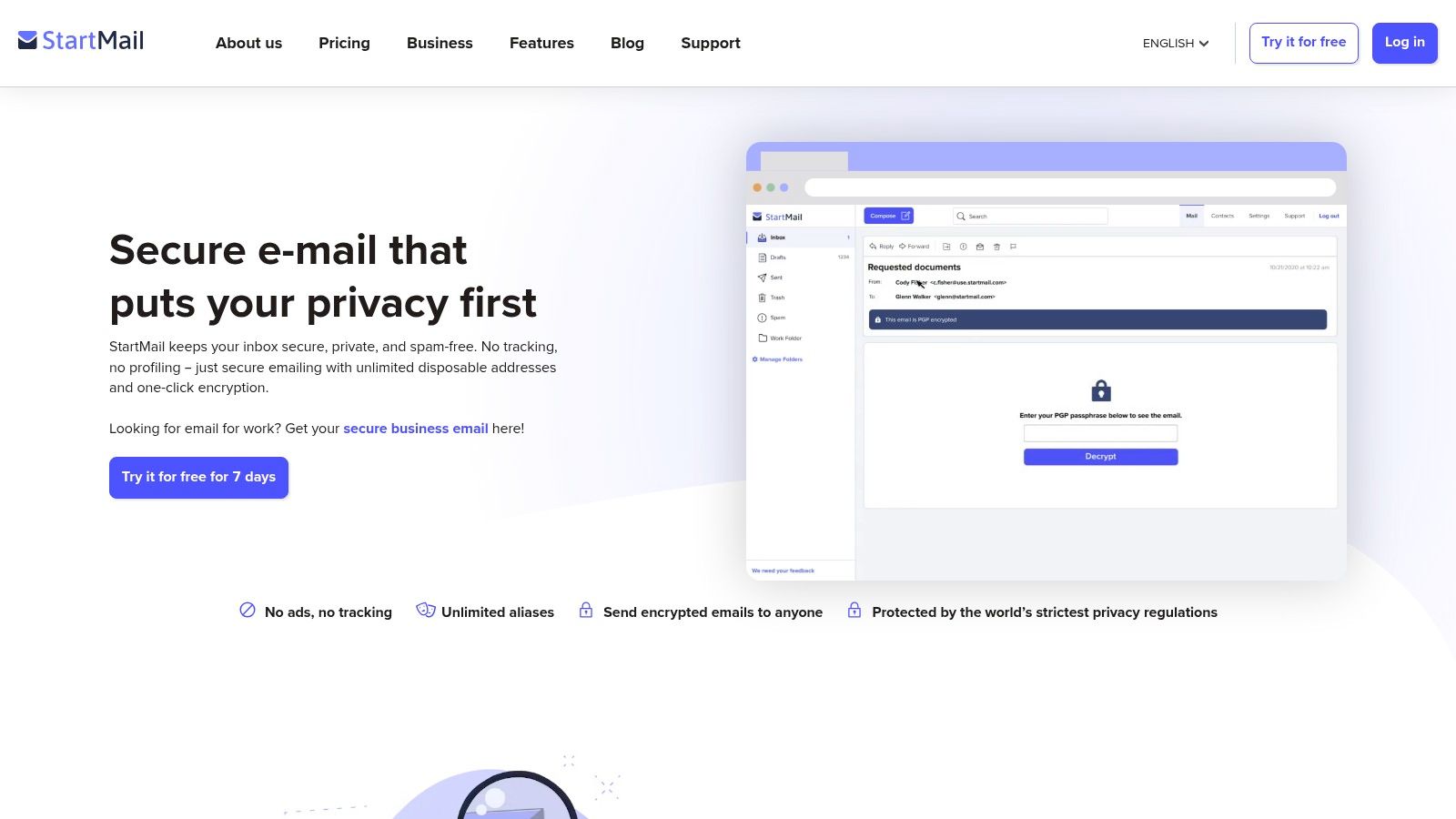
One of StartMail's most valuable features is its unlimited email aliases, which allow you to create disposable addresses on the fly. This is perfect for signing up for newsletters or services without revealing your primary email, significantly reducing spam and protecting your identity. Its clean interface and support for IMAP/SMTP mean you can easily integrate it with your favorite third-party email clients like Outlook or Thunderbird.
Key Features and Pricing
StartMail does not offer a free plan, instead focusing entirely on its premium, privacy-first service. This business model ensures its revenue comes from subscriptions, not from selling user data.
- Personal Plan: Starts at $59.95/year, offering 10 GB of storage, unlimited aliases, and support for custom domains.
- Business Plan: Custom pricing is available for teams, which includes an administrative console for easy user management and organization-wide security settings.
While it may lack the comprehensive ecosystem of services like a calendar or cloud drive that some competitors offer, StartMail excels at its core mission: providing a simple, secure, and private email experience. For those looking for one of the best encrypted email services that is easy to use and champions user anonymity through features like aliases, StartMail is an excellent and focused choice.
Website: https://www.startmail.com
7. Mailbox.org
Operating out of Germany, Mailbox.org offers more than just encrypted email; it provides a full productivity suite built with privacy at its core. It distinguishes itself by bundling secure email, calendar, contacts, cloud storage, and even video conferencing into one cohesive package. This makes it a powerful alternative for users looking to de-Google their digital life without sacrificing functionality, positioning it as one of the best encrypted email services for those who need an all-in-one solution.
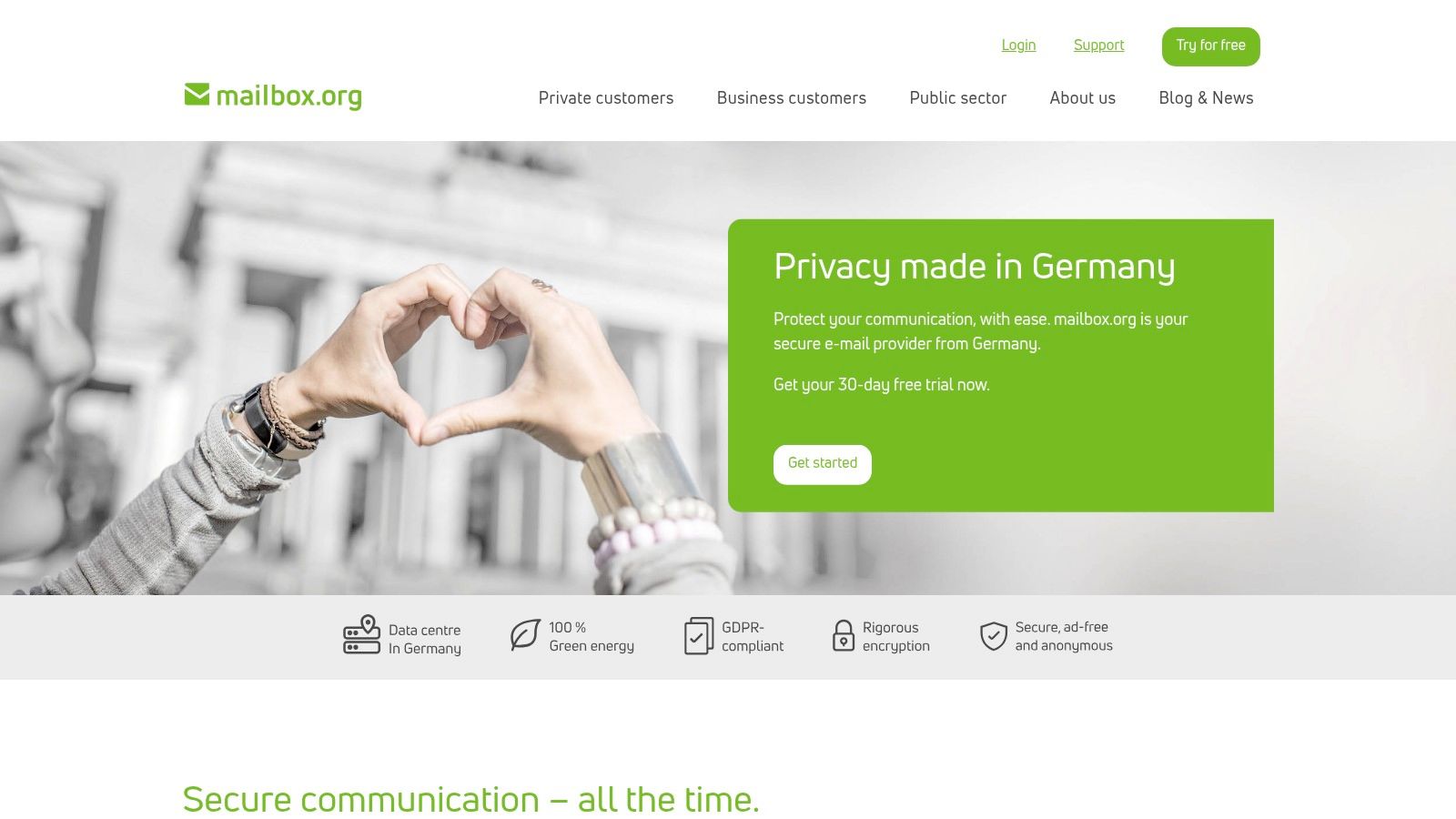
The platform is powered by 100% eco-friendly energy and enforces robust German data protection standards. Its user interface is clean and functional, integrating established open-source tools like Dovecot and Roundcube. A key advantage is its straightforward implementation of PGP encryption, allowing users to secure their communications with a few simple clicks directly within the webmail interface.
Key Features and Pricing
Mailbox.org does not offer a free plan, instead focusing on providing a premium, ad-free experience with a low-cost entry point. The plans are designed to scale based on storage and feature needs, making them suitable for individuals and small teams.
- LIGHT: For just €1/month, this plan provides 2 GB of mail storage, 3 aliases, and basic calendar/contact sync.
- STANDARD: At €3/month, users get 10 GB of mail storage, 25 GB of cloud storage, support for custom domains, and access to the online office suite.
- PREMIUM: Starts at €9/month, offering 25 GB of mail storage, 100 GB of cloud storage, and expanded features for professional use.
Its comprehensive feature set and commitment to user privacy under strong German jurisdiction make it a compelling choice. While some advanced security features might present a slight learning curve for beginners, the platform’s extensive documentation provides clear guidance.
Website: https://mailbox.org
8. Posteo
Operating out of Germany, Posteo offers a unique blend of robust security, a strong commitment to user anonymity, and an impressive focus on sustainability. Unlike many providers, Posteo is entirely self-financed and ad-free, ensuring its operations are aligned solely with its users' privacy interests. It stands out by facilitating anonymous sign-up and payment methods, such as cash by mail, allowing users to create an account without leaving a digital financial trail.
The service is powered by 100% green energy from Greenpeace Energy, making it an excellent choice for environmentally-conscious individuals. Posteo's interface is straightforward and functional, providing essential tools like an integrated calendar and address book that sync across devices. While it doesn't offer a free plan, its low-cost, all-inclusive model provides exceptional value, making it one of the best encrypted email services for those prioritizing privacy and ethics over extensive features.
Key Features and Pricing
Posteo's pricing is refreshingly simple, with a single, affordable plan that covers all its core features. There is no free tier, a deliberate choice to ensure financial independence and a business model that isn't reliant on data.
- Standard Plan: Costs just €1/month. This includes 2 GB of storage, two aliases, and access to all security and privacy features.
- Storage Upgrades: Users can increase their storage up to a maximum of 20 GB, with each additional GB costing €0.25/month.
The platform provides comprehensive encryption for data in transit and at rest. While end-to-end encryption is supported via OpenPGP and S/MIME, it requires user-side configuration with a compatible email client like Thunderbird. This approach gives users more control but involves a steeper learning curve compared to services with built-in E2EE.
Website: https://posteo.de
9. Zoho Mail
Emerging from a comprehensive suite of business applications, Zoho Mail provides a secure and professional email solution that prioritizes user privacy. While it's widely recognized for its business tools, its email service stands on its own as a powerful option for both individuals and companies seeking an ad-free, encrypted environment. Based in India, Zoho offers a compelling package by integrating robust security with a full-featured productivity ecosystem.
Zoho Mail ensures data is encrypted both at rest and in transit, using TLS for connections and offering S/MIME for end-to-end message encryption. Its user interface is clean and highly customizable, allowing users to tailor the experience to their workflow. The real standout feature is its seamless integration with other Zoho apps like Docs, Calendar, and Projects, making it a unified hub for productivity and one of the best encrypted email services for business users.
Key Features and Pricing
Zoho Mail offers a "Forever Free Plan" that supports up to five users on a single domain, which is exceptional for small teams, although it has a 5 GB per user storage cap. Its paid plans are highly competitive and scale effectively.
- Mail Lite: Starting at just $1/user/month, this plan offers 5 GB or 10 GB of storage, custom domain support, and a host of routing and collaboration features.
- Mail Premium: For $4/user/month, storage is boosted to 50 GB per user and adds advanced features like email backup, S/MIME encryption, and white-labeling options.
The platform's commitment to being completely ad-free, even on the free plan, is a significant advantage for privacy-focused users. For those who need more than just email, Zoho Mail’s integration capabilities offer a level of convenience and efficiency that is hard to match.
Website: https://www.zoho.com/mail
10. Runbox
Operating out of Norway, Runbox offers a unique proposition in the secure email market by combining strong privacy protections with a firm commitment to environmental sustainability. Its services are powered entirely by renewable hydropower, making it an excellent choice for users who prioritize both data privacy and ecological responsibility. Runbox provides robust security features, including PGP encryption support and two-factor authentication, all protected by strong Norwegian privacy laws.
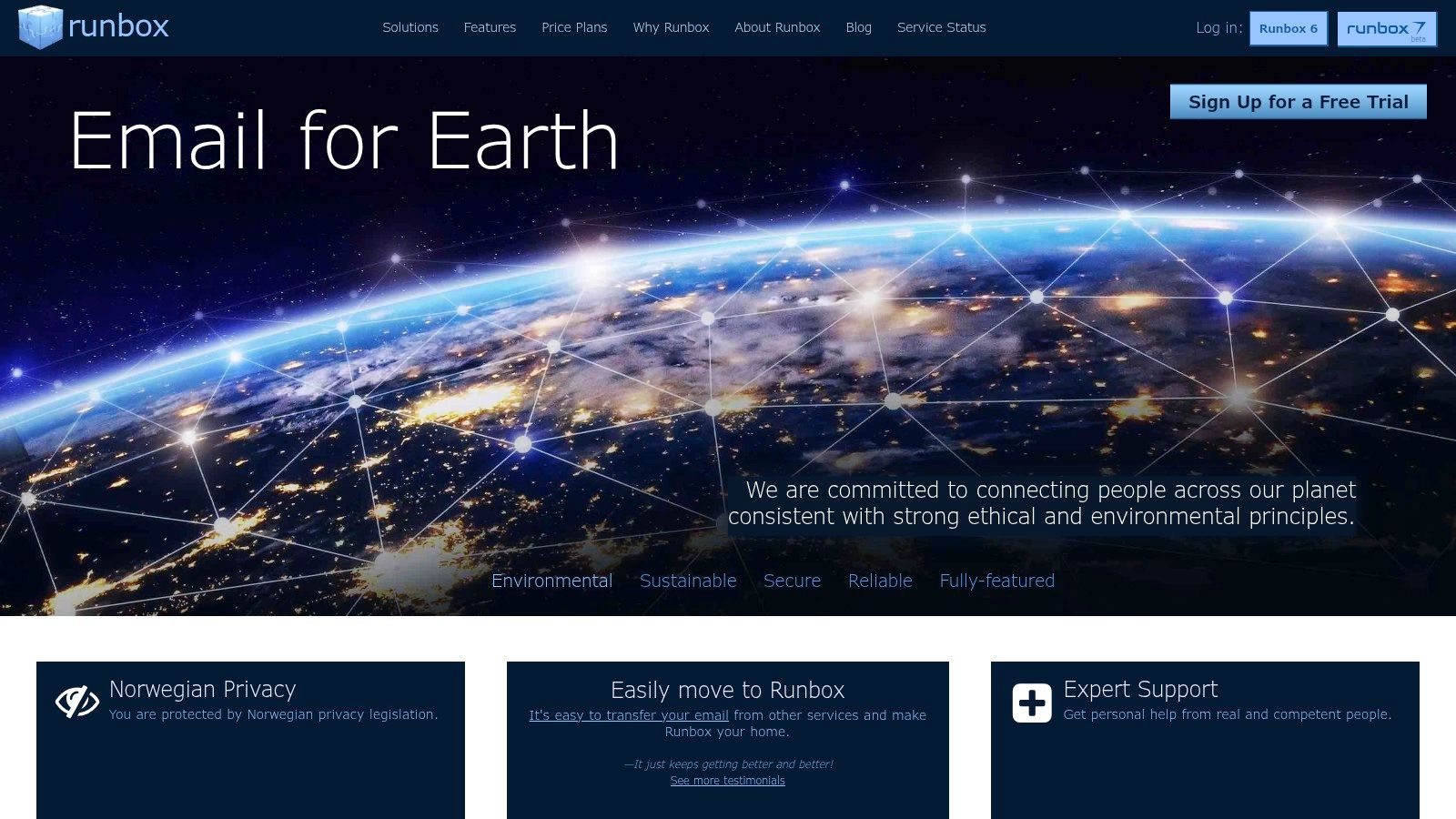
The platform is designed with a clean and user-friendly webmail interface, ensuring a smooth transition for those accustomed to mainstream email providers. A key advantage is its integration of email hosting with encrypted cloud storage, allowing users to securely manage both their communications and files within a single, privacy-focused ecosystem. While it doesn't offer a free plan, its paid tiers are competitively priced for the features provided.
Key Features and Pricing
Runbox focuses on providing a reliable, ad-free experience with transparent pricing. It doesn't have a free tier, instead offering a 30-day free trial on all its plans to allow users to test the service thoroughly.
- Micro: Starts at $19.95/year, providing 2 GB of mail storage and 200 MB of file storage, ideal for light personal use.
- Mini: At $34.95/year, this plan increases storage to 10 GB for mail and 1 GB for files, along with support for one custom domain.
- Medium: For $49.95/year, users get 25 GB of mail storage and 2 GB for files, plus support for five custom domains.
- Max: The top-tier plan costs $79.95/year and includes 50 GB of mail storage, 10 GB of file storage, and support for 25 custom domains.
With its strong ethical foundation, solid security infrastructure, and user-centric design, Runbox is one of the best encrypted email services for individuals and small businesses looking for a dependable and sustainable provider.
Website: https://runbox.com
11. Librem Mail
Developed by Purism, a company dedicated to building privacy-respecting hardware and software, Librem Mail is a key component of the Librem One bundle. It offers end-to-end encrypted email with a strong ethical foundation, appealing to users who want to support a broader ecosystem committed to digital freedom. The service leverages standard OpenPGP encryption, ensuring that your communications remain private and secure from interception.
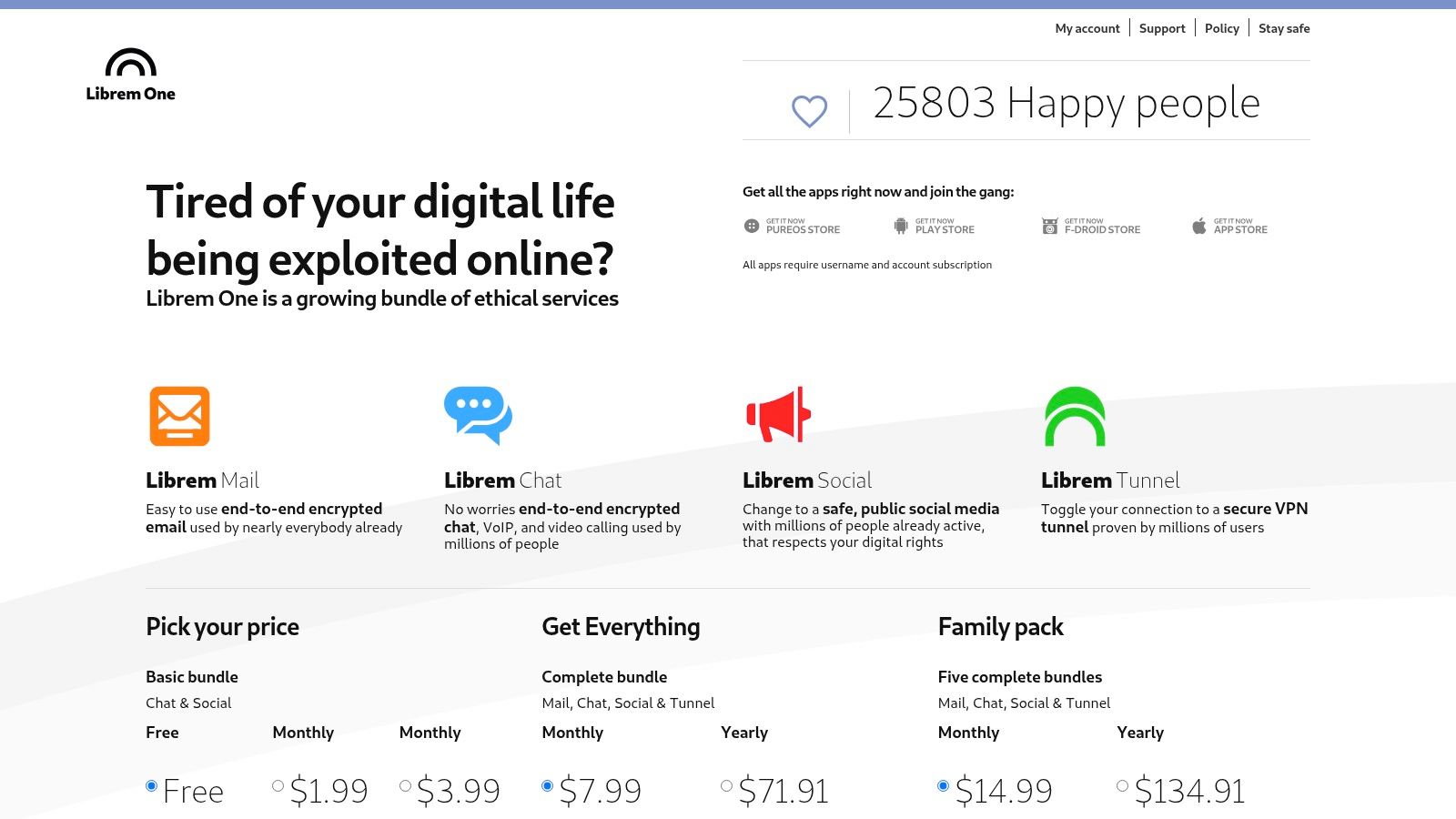
What sets Librem Mail apart is its integration into a comprehensive suite that includes a chat client, social media platform, and VPN. This holistic approach provides a seamless, privacy-first alternative to mainstream tech giants. A notable security feature is its policy of automatically deleting unencrypted emails from the server after 30 days, minimizing your data footprint.
Key Features and Pricing
Librem Mail does not offer a free tier, positioning itself as a premium, all-in-one privacy solution. Its pricing is straightforward, bundling all its services into a single subscription model. This makes it an excellent choice for those looking to de-google their digital life completely.
- Librem One Basic: For $1.99/month, this plan includes Librem Mail, Chat, and Social.
- Librem One Plus: At $5.99/month, it adds the Librem Tunnel (VPN) to the basic package.
- Librem One Family: Starting at $14.99/month, this plan provides accounts for up to five family members.
While it lacks a free plan and its storage is more limited than some competitors, its user-friendly interface and bundled services present a compelling value proposition. For users seeking one of the best encrypted email services that is part of a complete privacy suite, Librem Mail is a strong contender.
Website: https://librem.one
12. Fastmail
Operating from Australia, Fastmail has built a strong reputation over two decades by focusing on speed, reliability, and user privacy. While it does not offer end-to-end encryption by default like some zero-knowledge providers, it secures data with robust encryption in transit and at rest. Fastmail stands out as a premium, ad-free alternative to mainstream services, prioritizing a clean and efficient user experience over data monetization.
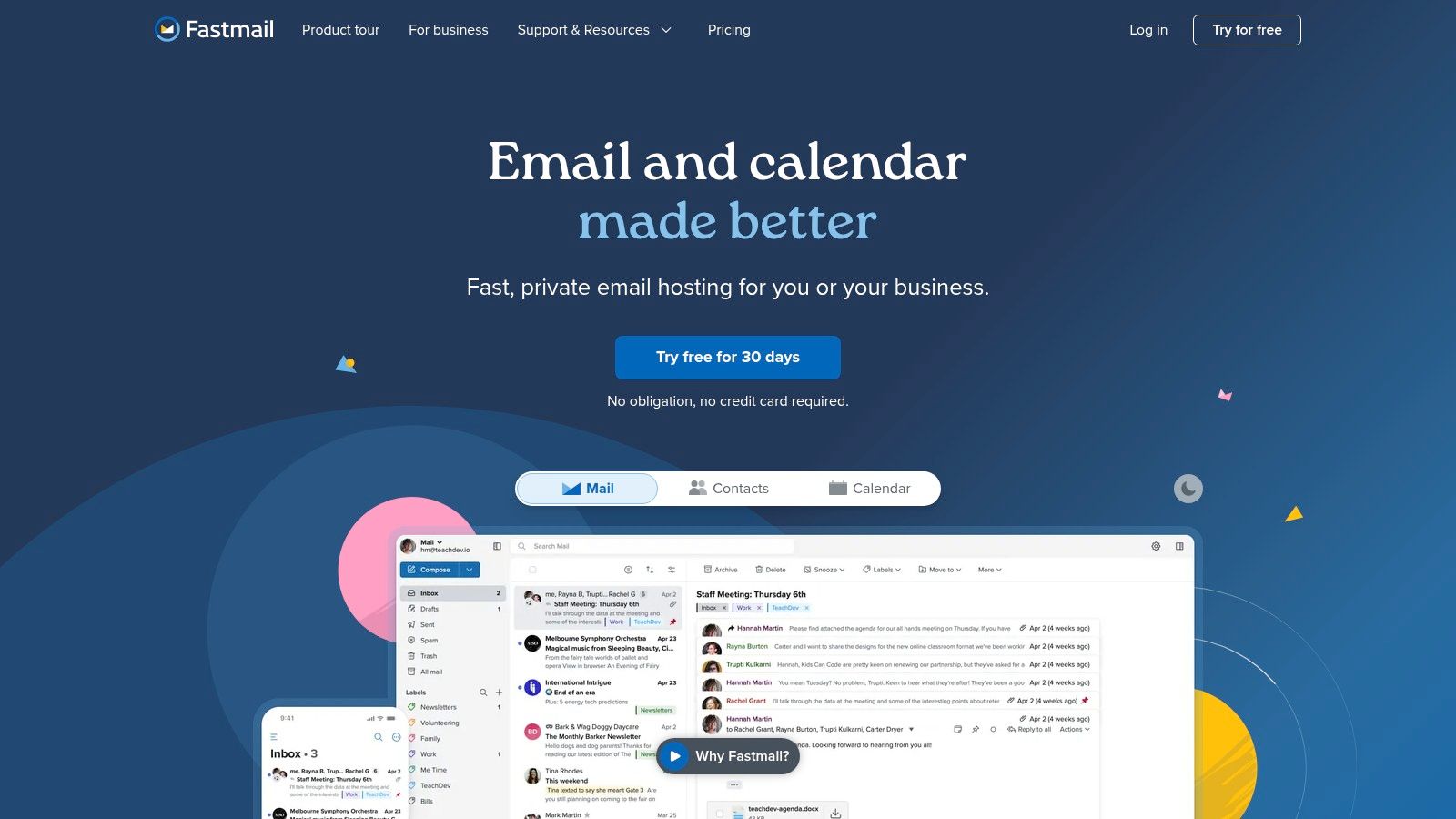
The platform is celebrated for its powerful, web-based interface that feels incredibly responsive, along with its excellent search functionality. Fastmail fully supports open standards like IMAP and SMTP, allowing seamless integration with third-party email clients. For users seeking one of the best encrypted email services that combines traditional email functionality with modern security practices and a commitment to privacy, Fastmail presents a compelling case.
Key Features and Pricing
Fastmail is a paid-only service, which underpins its ad-free, privacy-first business model. It offers a 30-day free trial to test its features before committing.
- Basic Plan: Starts at $3/month, offering 2 GB of storage per user, email, and calendar support.
- Standard Plan: At $5/month, this plan increases storage to 30 GB and adds support for custom domains, making it ideal for professionals and small businesses.
- Professional Plan: For $9/month, users get 100 GB of storage and archived email storage, targeting power users and teams with higher demands.
A significant advantage is its sophisticated rule and filter system, which gives users granular control over their inbox. While it may not have the default E2EE of competitors like ProtonMail, its dedication to security, speed, and a superior user experience makes it a top-tier choice for those who value performance and privacy.
Website: https://www.fastmail.com
Encrypted Email Services Feature Comparison
| Service | Core Features/Characteristics | User Experience/Quality ★ | Value Proposition 💰 | Target Audience 👥 | Unique Selling Points ✨ |
|---|---|---|---|---|---|
| 🏆 Typewire | Secure private email, custom domains, anti-spam & virus filters, Vancouver-based servers | ★★★★☆ Fast, responsive UI with light/dark modes | Free, Basic, Premium plans with 7-day trial | Privacy-conscious individuals, SMBs, IT pros | Privacy by design, no ads/tracking, own data centers |
| ProtonMail | End-to-end encryption, open-source, self-destructing emails | ★★★★☆ Easy to use, mobile apps | Free & Paid plans | Privacy-focused users, individuals | Swiss privacy laws, open-source transparency |
| Tuta (Tutanota) | End-to-end encryption (email/calendar/contacts), post-quantum crypto | ★★★★☆ User-friendly | Affordable paid plans | Privacy enthusiasts, SMBs | Post-quantum security, open-source |
| Hushmail | OpenPGP encryption, HIPAA-compliant plans, e-signature forms | ★★★★☆ User-friendly UI | Paid plans only | Healthcare, legal, business users | Industry-specific solutions (HIPAA) |
| Mailfence | Encryption with OpenPGP, digital signatures, calendar & docs | ★★★★☆ Strong security tools | Free & Paid plans | Security-conscious professionals | Integrated collaboration suite |
| StartMail | PGP encryption, unlimited aliases, 10GB storage | ★★★★☆ Simple UI | Paid plans only | Privacy-focused individuals | Unlimited aliases, no ads/tracking |
| Mailbox.org | PGP encryption, calendar, contacts, encrypted cloud storage | ★★★★☆ Robust toolset | Paid plans only | Businesses & privacy advocates | Video conferencing, integrated cloud storage |
| Posteo | End-to-end encryption, anonymous signup/payment, 2GB storage | ★★★☆☆ Fair UI | Paid plans only | Privacy & eco-conscious users | Anonymous signup, 100% green energy |
| Zoho Mail | End-to-end encryption, productivity tools integration | ★★★★☆ Feature-rich | Free & Paid plans | Businesses & individuals | Integrated productivity suite |
| Runbox | PGP encryption, 2FA, encrypted cloud storage, renewable energy | ★★★★☆ User-friendly | Paid plans only | Privacy & sustainability focused | Powered by renewable energy |
| Librem Mail | End-to-end encryption, built-in VPN, auto deletion of unencrypted emails | ★★★★☆ Privacy focused | Paid plans only | Privacy advocates, tech-savvy | Integration with Librem One VPN |
| Fastmail | 2FA, custom domains, calendar/contacts integration, no ads | ★★★★☆ Fast, reliable | Paid plans only | Individuals & businesses | Speed & reliability |
Final Thoughts
Navigating the landscape of secure communication can feel complex, but as we've explored, the path to digital privacy is more accessible than ever. The core takeaway from our deep dive into the best encrypted email services is that there is no single, perfect solution for everyone. Instead, the "best" service is the one that aligns precisely with your specific threat model, technical comfort level, and daily workflow requirements.
For some, the an all-in-one privacy suite like Proton Mail, with its integrated calendar, VPN, and cloud storage, offers a seamless and powerful ecosystem. For others, the uncompromising open-source principles and post-quantum cryptography of Tuta (formerly Tutanota) represent the pinnacle of security. The choice isn't just about features; it's about philosophy and trust.
How to Choose the Right Encrypted Email for You
Making the final decision requires a careful assessment of your own needs. To simplify this process, consider the following framework to guide your choice:
- For the Everyday Privacy Seeker: If your goal is to escape the data-mining practices of mainstream providers like Gmail and Outlook, services like Posteo and Mailbox.org offer an excellent balance. They deliver robust privacy features, sustainable business models, and user-friendly interfaces without a steep learning curve.
- For Small Businesses and Professionals: When custom domains, user management, and HIPAA compliance are non-negotiable, solutions like Hushmail for Business, Zoho Mail, and Mailfence shine. They provide the administrative controls and professional features necessary to run a business securely while maintaining end-to-end encryption.
- For Journalists, Activists, and the Highly Security-Conscious: If your work exposes you to significant digital threats, your evaluation criteria must be stricter. Prioritize services with a proven track record, strong jurisdictional advantages (like Switzerland), open-source codebases, and advanced features like anonymous sign-up options. Proton Mail and Tuta are often the top contenders in this category.
- For the Tech-Savvy User and Developer: If you value flexibility, integration capabilities via IMAP/SMTP, and a more classic email experience enhanced with modern security, options like Fastmail and Runbox are compelling. They cater to users who want more control over their clients and workflow without sacrificing privacy.
Final Implementation Checklist
Before you fully commit and migrate your digital life, take these final steps to ensure a smooth transition:
- Utilize the Free Tier: Most services, including Proton Mail and Tuta, offer a free plan. Use it as a sandbox to test the user interface, mobile apps, and overall feel of the platform.
- Review the Privacy Policy: Don't just skim it. Understand what metadata is logged, how long it's kept, and the legal jurisdiction the company operates under. This is a critical step in verifying a provider's claims.
- Plan Your Migration: Set up forwarding from your old email account. Export your contacts. Decide whether you need to import old emails or are comfortable with a fresh start. A phased approach is often less stressful than an abrupt switch.
Ultimately, choosing one of the best encrypted email services is a proactive step toward reclaiming your digital autonomy. It's an investment in your privacy and a statement that your personal communications are not a commodity to be mined and sold. By making this deliberate choice, you are not just adopting a new tool; you are embracing a more secure and private way of engaging with the digital world.
Ready to elevate your team's communication with a tool designed for secure, efficient collaboration? While the services above focus on external email, Typewire provides a secure, internal platform that organizes your team's most important updates, discussions, and knowledge. Discover how a dedicated space for asynchronous communication can reduce internal email clutter and keep your entire team in sync at Typewire.

